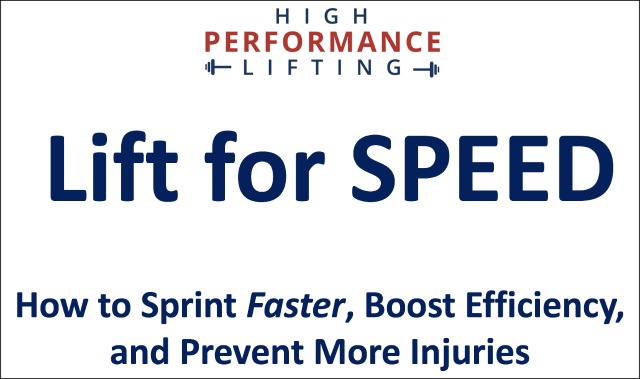Adult runners need more hard training. And by “hard training,” I mean focusing more on muscle fiber recruitment!

But first, let me back up and explain. I started running when I was 14 and continued for eight years, competing at both the high school and college levels. I basically have a PhD in short shorts.
My perspective on the sport of running was shaped by the intense competition of track and cross country.
We did a lot of challenging things:
- Sprints: Running at maximum effort.
- Races: By their very nature, these are run at 100% effort.
- Strides and hill sprints: Performed at 95-100% of maximum speed.
- Heavy weightlifting: The focus was on strength and power, not endurance or muscle growth.
- Long runs: Two hours or more of running, which has similar effects to running very fast.
- Plyometrics and drills: These included power-focused skips, bounds, and jumps.
- Hill workouts: Running uphill at various speeds against gravity.
After college, I began coaching adult runners. Since 2010, I’ve worked with thousands of older athletes globally, with goals ranging from completing their first ultramarathon to qualifying for Boston and racing a sub-20 minute 5k.
I’ve noticed a pattern. Younger, competitive runners tend to do more of the activities I listed earlier. They run hard, lift weights, run long distances, and develop athletic skills through plyometrics and drills. They engage in difficult activities!
In contrast, older runners generally do not. The common thread among all these challenging activities is that they engage far more muscle fibers than easier activities.
This has significant implications for the health and performance of runners who consistently perform them.
The Value of Muscle Fiber Recruitment
It’s helpful to think of muscle fiber recruitment as “using more of your muscle.” Challenging activities require more from your muscles.
To accomplish this, the central nervous system sends electrical signals to individual muscle cells (fibers) to make them contract. A simple example is comparing an easy run with a maximum-effort race. The easy run doesn’t require much muscle fiber recruitment because each stride generates a low amount of force, resulting in a lower step rate and a shorter stride.
However, a race demands more from your muscles. To generate more force, you recruit more muscle cells, leading to a higher cadence and a longer stride.
The same principle applies to heavy weight training. Lifting a broomstick off the floor doesn’t require you to generate much force; it uses very little of your muscles. But if you replace that stick with a barbell loaded with heavy plates, you must activate more fibers to generate more force!
Runners have a strong interest in doing more activities that require higher muscle fiber recruitment. The good news is that this is a skill that can be developed!
Advanced runners are very familiar with this skill. They know how to recruit more muscle fibers efficiently and powerfully, generating greater force with less wasted motion. They have high neuromuscular fitness, meaning the communication between their brain and muscles is highly efficient.
This skill leads to improved running economy (less energy is used to run at a given effort) and better performances (i.e., you race faster!). A review of the literature clearly shows that one way of recruiting muscle fibers – lifting weights – improves running economy.
It also boosts strength and durability, helping runners stay healthy and prevent injuries. When you have better access to more of your muscle fibers, can run more economically with less wasted movement, and can generate higher forces (i.e., you’re stronger), you’ll be far less likely to get running injuries.
Recruit More Muscle Fibers: Your How-To
Now that we understand the importance of regularly recruiting as many muscle fibers as possible, we need to incorporate high-recruitment activities into our training plan. Fortunately, most runners already include some of these elements! We just need to be more consistent over time.
Focus on the activities mentioned earlier:
- Sprints / Speed development
- Races (the shorter, the better)
- Strides and hill sprints
- Lifting weights (relatively heavy)
- Long runs
- Drills and plyometrics
- A variety of hill workouts
These activities are at the “high recruitment” end of the muscle fiber recruitment spectrum, but they don’t all achieve this through the same mechanism. Most (like maximum-effort running and heavy lifting) recruit more muscle fibers because they are intense, high-power, and high-force activities.
Long runs and hill workouts work differently. These runs gradually tire out muscle fibers so that more and more fibers need to be recruited to compensate. As we get tired, our slow-twitch fibers fatigue, and we begin recruiting more fast-twitch fibers. This has the dual benefit of training fast-twitch fibers for endurance and teaching them to work better in conjunction with slower-twitch fibers.
While drills and plyometrics are high-force activities, they also encourage us to recruit fibers in the correct sequence. They help us achieve a larger range of motion, improve coordination, and increase our ability to produce force quickly. You might see your ground contact time decrease as you strike the ground more powerfully and “bounce” into your next stride!
When done regularly, these activities will give athletes the benefits of speed, better performance, injury resilience, and strength.
Progress Slowly!
All the training activities mentioned here are difficult and should be seen as “high risk, high reward.” None of us should start aggressive plyometrics, speed work, long runs, or weightlifting without first ensuring we’re ready.
Regardless of your current ability, you can take steps to recruit more muscle fibers:
- Slowly increase the distance of your long run.
- Transition strength training from body weight to weighted exercises.
- Run strides 2-3 times per week.
- Add 2-3 form drills to your training before workouts.
- Race regularly, including shorter tune-up races.
If you are following a well-designed training program or have a coach, you can gradually add plyometrics, explosive weightlifting movements, and speed development. These activities carry the highest risk of running injuries, so follow best practices and always be cautious!
This gradual approach will help you improve the skill of muscle fiber recruitment while keeping the risk of injury as low as possible.
Soon, you’ll be a stronger, faster, and healthier runner!
Change One Thing Today
Strength training is arguably the best way to focus on muscle fiber recruitment and the potential to absolutely transform your training.
Just consider:
- I’ve seen it in my personal running and that of my private clients
- It’s supported by the scientific literature in study after study
- The training patterns of countless world-class runners all include a regular dose of strength training
Now, it’s time to ask yourself some important questions…
- Would you like to improve your running economy and run with less effort?
- Does being a stronger and more powerful athlete sound good to you?
- Would you like to strengthen everything from your muscles to tendons, ligaments, bones, and everything in between?
- How would you like to avoid your next big injury (and turn your next niggle into nothing at all)?
- Would you like to be able to run faster, finish races strong, and feel more coordinated while sprinting?
The good news is that if you lift like a runner, all of these results can be yours.
It’s possible. And it won’t take you hours in the gym every day.
I’m going to address the most pervasive myths that surround strength training exercises for endurance runners so you don’t waste time.
You’ll learn:
- Why no runner should ever lift for endurance
- How guarding against impact can prevent your next injury
- Why it’s not necessarily how much you lift but how you lift it (movements matter!)
- And a lot more…
If you want in, then I’m excited to announce our new strength training ecourse!
Sign up here for your first coaching lesson.
This is going to be an exciting journey into the role of strength training exercises for runners with actionable examples that I think you’re going to love.
I’m stoked about this topic so get excited, join us, and prepare yourself for an incredible year of PR’s!
